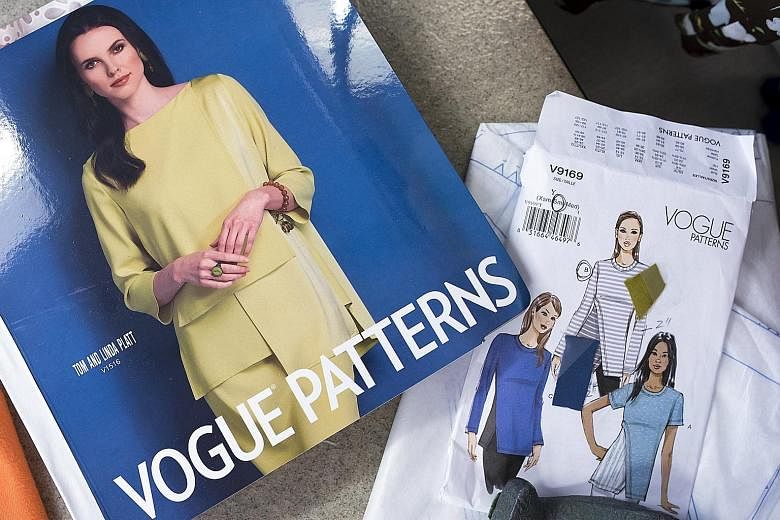NEW YORK • The Internet did little to disrupt it. Globalisation could not shut it down. But while McCall Pattern Company, the home-sewing brand founded in 1863, may seem like a business that time forgot, it finds itself newly fashionable.
The company's headquarters has the look of a corporate environment in the days before digital culture banished clutter. There on the 34th floor of the Equitable Building, a 1915 skyscraper in Manhattan's financial district, you will find rooms filled with buttons and zippers, bolts of fabric on work tables and metal file drawers stuffed with paper pattern packets.
There is a pattern-making room, where muslin is fitted to dress forms; a dressmaking room, where women at sewing machines make sample garments; and a photo studio, where models pose for simple shoots that emphasise the clothes, rather than sex or sizzle.
For the 80 or so employees, home sewing is not so much a retro thing as it is a timeless pursuit.
"I've done this long enough to know that people have it in their hearts," said Ms Carolyne Cafaro, the creative director. "There could be one pattern company left in the world, but I do think people will always sew."
Ms Cafaro's brief is to oversee the creation of about 700 patterns each year for the four lines that fall under the McCall Pattern Company banner. Each of the lines - McCall's, Butterick, Kwik Sew and Vogue Patterns (its name licensed from Conde Nast) - has its own catalogue, which sewing enthusiasts find at fabric shops.
Ms Meg McDonald, who two years ago became the company's first social media manager, said she was troubled recently when she came across a photo of one of McCall's distinctively illustrated envelopes in a nostalgic Do You Remember? post on Facebook. There it was, a representation of the company she works for, alongside rotary phones and carousel slide projectors taken from the collective cultural attic.
"So here's a perfect example of the 'Huh, you guys are still in business?' thing that happens to us all the time," Ms McDonald said.
But if there is a sense in the broader culture that McCall belongs to the Betty Draper past, the opposite view is held among 21st-century sewers. The patterns created here are blueprints, essential enablers for do-it-yourself- minded women and men who want to look stylish without plunking down thousands at a department store or the latest pop-up shop.
A new appreciation for artisanal crafts has led the Etsy generation to embrace sewing. Once done mainly out of economic necessity, making clothes at home is back in fashion, relatively speaking.
Vintage McCall patterns licensed from designers such as Diane von Furstenberg or Dior command hundreds of dollars on eBay.
Lately, McCall has been mining its past to build a bridge to the future, posting images from its impressive archive to social media sites such as Instagram and Pinterest. One of the publications showing its wares, Vogue Patterns, is a fashion treasure trove and looking through old issues underscores the historical ties between the pattern companies, high fashion and Hollywood.
Part of the goal of posting the archive images, said Ms McDonald, is to spark curiosity among young people, many of whom were not taught sewing in school.
To liven up its product, McCall has struck deals with popular sewing bloggers and turned them into designers.
Blogger-turned-designer Nikki Brooks-Revis, 36, works for McCall's line. She began sewing four years ago, she said, after amending her long-held view: "My thought was old people sew. Young, hip people did not sew." She started a personal fashion blog and discovered sewing as a way to produce an ever-changing wardrobe on a budget. She loved the way she could alter a pattern and customise a garment.
Sewing patterns were, in a sense, the original fast fashion: a quick, affordable, stylish option before the advent of the US$20 (S$27) H&M dress. One of the company's greatest hits is the Walkaway dress, a Butterick pattern from 1952.
"It was called the Walkaway dress because you could sit down at a sewing machine in the morning and walk away wearing it to lunch," Ms Cafaro said. The pattern is still available in the Butterick catalogue, reissued for a new generation.
NEW YORK TIMES

